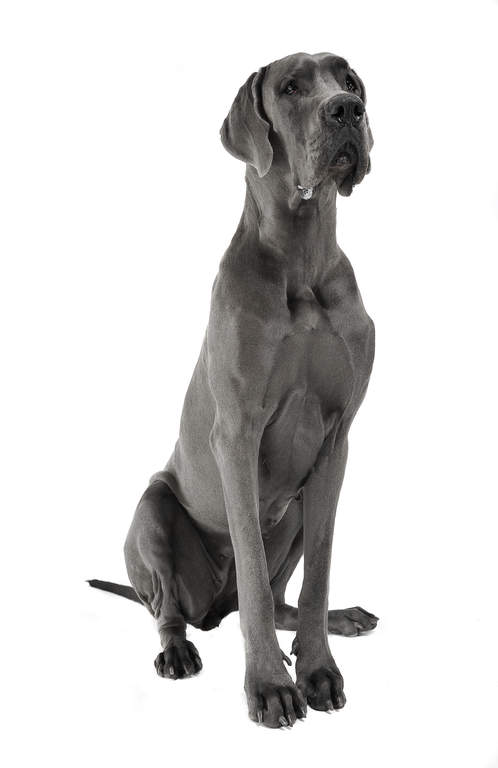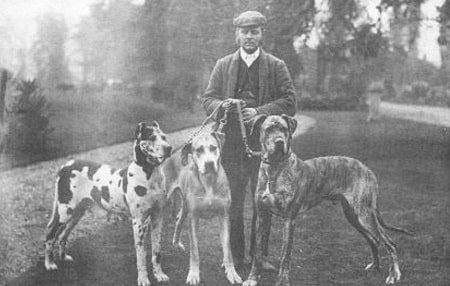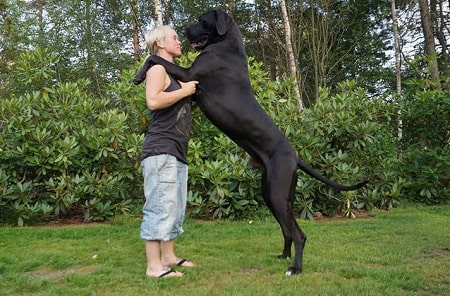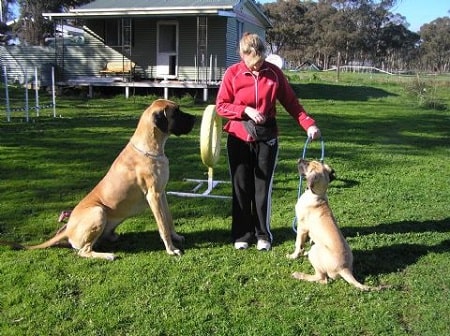The Great Dane is a perfect family dog. This gentle giant is a perfect dog for you if you are looking for a huge loving dog. Sweet, affectionate and loving with children, this large looking dog is known for its giant size.
Great Dane Dog Breed Overview

| Group: | Working group |
| Size: | Extra large (110-190 pounds) |
| Lifespan: | 8-10 Years |
| Best Suited For: | Families |
| Temperament: | Devoted, friendly, confident, loving |
| Exercise Needs: | Moderate |
| Drooling Potential: | Moderate/td> |
| Grooming Needs: | Moderate |
| Similar Breeds: | Greater Swiss Mountain Dog, Mastiff, Boxer |
1. Basic features
The Great Dane is taller than most people when standing on its hind legs. He is as tall as 32 inches at the shoulders.
He is a German domestic dog and is very well known for its huge size.
Although the Great Dane is one of the largest breeds, they’re very gentle. Great Danes are sweethearts on the inside and are a perfect family companion. They’d love to cuddle up with you all day.
Unusual for its appearance, Great Danes are very friendly with other animals and children. They even tend to seek physical affection from their owners. They are even known to be the world’s largest lapdogs due to their preference to lean against and sitting on their owners.
2. Great Dane Origin

Great Danes were originally bred to hunt boars, giving them the name of Boar Hounds. Dogs looking similar to Great Danes are found in Egyptian artifacts.
They are known to be originated in Germany and were ferocious at that time. Later, they served as protectors of the estates.
The German breeders, even after the 1800s continued refining the breed. They primarily focused on the dog’s temperament. As they were used to hunt boars, Great Danes were aggressive. The breeders tried to produce more loving and gentle breeds and thus, they succeeded.
3. The Personality of Great Dane
Deceptive to its appearance, the Great Dane is a loving and affectionate pet. They’re great with children and other pets when raised along with them.
Though they are gentle, Great Danes are great protectors and guardians. They guard the house perfectly and are wary of strangers. They show a lot of courage when needed.
4. Great Dane Behavior
Great Danes are people pleasers who make friends easily. They are elegant and sharp. They generally do not have a high prey drive and are not aggressive.
It is important to socialize your Great Dane properly in order to avoid any unwanted circumstances.
Great Danes are great with other dogs and other pets especially when raised along with them. They are very friendly and love children. Great Danes are gentle with children and ten to mix up well with strangers as well.
However, they are excellent protectors as well. A Great Dane can become aggressive if not trained and socialized properly, which should strongly be avoided.
5. Exercise Requirements

Although Great Danes may seem cuddly couch potatoes, they need a daily walk. Great Danes require daily exercise according to their age and size. They usually have a tendency to run, so should be kept in a fenced area or a leash.
Rigorous exercise should be avoided in young Danes due to their fast growth. Over-exercising can cause bone and joint problems in Great Dane puppies. Exercise around mealtimes should also be avoided to prevent a bloat.
While still growing, steps should be taken to minimize Dane’s activity to avoid any damage.
6. Diet Needs
Up to five months, a Great Dane should have three meals per day. After that, two meals per day for life. Proper diet for a large dog breed like Great Dane is very important. A high-quality food, when given in proper amount and appropriate according to the dog’s age will do great.
Foods with high-fat content should be avoided. Great Danes are prone to bloats. Exercising during meal times and taking smaller meals can help reduce the risk of bloat in Danes.
7. Trainability

Being a large breed, it is very important to train a Great Dane in order to prevent any damage. Obedience training is a must in young dogs. Early socialization training should be provided exposing them to different people, circumstances and places. This way a Great Dane will develop into a well-adjusted adult.
Great Danes respond well to training and firm training methods. Being friendly and sociable, they love being around people.
Great Danes are great with children if trained correctly at the right age.
8. Common Health Problems
Like most large dogs, Great Danes have a slow metabolism. Due to this, they are prone to many gastric problems like bloating. To avoid bloating, a proper rest after meals is necessary before any exercise.
Great Danes are at a risk to Hip Dysplasia too. This is an associate heritable condition within which the leg bone does not work snugly into the hip. Some dogs may show signs of hip dysplasia like pain and lameness. However, not all dogs show any outward signs of discomfort. So, an X-ray for hip evaluation is recommended.
Great Danes live around 6-8 years or a maximum of 10 years thus giving them a nickname of the heartbreak breed.
9. Who should Adopt a Great Dane
Great Danes make adorable pets. They’re loving to their families and are protective of them as well. Great Danes are suitable for apartment living though it may not seem so by their size. They do well in apartments as they do not require a very high need for exercise.
They are great with other pets, children, and strangers.
However, Great Danes do need time and affection of their owners. A Great Dane is perfect for you if you need a large dog who is cuddly and loves people.
